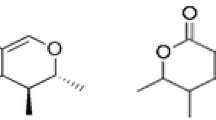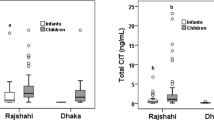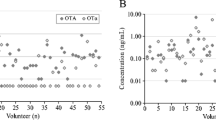Abstract
The mycotoxin citrinin (CIT) deserves attention due to its known toxic effects in mammalian species and a widespread occurrence in food commodities, often along with ochratoxin A, another nephrotoxic mycotoxin. Human exposure, a key element in assessing risks related to these food contaminants, depends upon mycotoxin levels in food and on food consumption. Yet, data available for CIT levels in food are insufficient for reliable intake estimates. Now biomonitoring, i.e., analysis of parent compound and/or metabolites in human specimen (blood, urine, breast milk), is increasingly used to investigate mycotoxin exposure. Biomonitoring requires sensitive methods for determining biomarkers of exposure, combined with kinetic data to conclude on the absorbed internal dose in an individual. Recent advances in LC–MS/MS-based analytical techniques have facilitated biomonitoring studies on the occurrence of CIT biomarkers in body fluids, mainly in urine samples. This review compiles evidence on human exposure to CIT in different countries, on CIT kinetics in humans, and on biomarker-based CIT intake estimates. Human CIT exposures are discussed in light of an intake value defined as ‘level of no concern for nephrotoxicity’ by the European Food Safety Agency, and some uncertainties in the toxicological data base. Further studies on CIT, including biomarker-based studies are warranted along with regular food surveys for this mycotoxin to protect consumers against undesirable health effects.


Similar content being viewed by others
References
Ali N (2018) Co-occurrence of citrinin and ochratoxin A in rice in Asia and its implications for human health. J Sci Food Agric 98:2055–2059. https://doi.org/10.1002/jsfa.8667
Ali N, Degen GH (2018) Urinary biomarkers of exposure to the mycoestrogen zearalenone and its modified forms in German adults. Arch Toxicol 92(8):2691–2700
Ali N, Blaszkewicz M, Degen GH (2015a) Occurrence of the mycotoxin citrinin and its metabolite dihydrocitrinone in urines of German adults. Arch Toxicol 89:573–578. https://doi.org/10.1007/s00204-014-1363-y
Ali N, Blaszkewicz M, Mohanto NC, Rahman M, Alim A, Hossain K, Degen GH (2015b) First results on citrinin biomarkers in urines from rural and urban cohorts in Bangladesh. Mycotoxin Res 31:9–16. https://doi.org/10.1007/s12550-014-0217-z
Ali N, Blaszkewicz M, Alim A, Hossain K, Degen GH (2016a) Urinary biomarkers of ochratoxin A and citrinin exposure in two Bangladeshi cohorts: follow-up study on regional and seasonal influences. Arch Toxicol 90:2683–2697
Ali N, Blaszkewicz M, Manirujjaman M, Degen GH (2016b) Biomonitoring of concurrent exposure to ochratoxin A and citrinin in pregnant women in Bangladesh. Mycotoxin Res 32:163–172. https://doi.org/10.1007/s12550-016-0251-0
Ali N, Muñoz K, Degen GH (2017) Ochratoxin A and its metabolites in urines of German adults-An assessment of variables in biomarker analysis. Toxicol Lett 275:19–26. https://doi.org/10.1016/j.toxlet.2017.04.013
Ali N, Hossain K, Degen GH (2018) Blood plasma biomarkers of citrinin and ochratoxin A exposure in young adults in Bangladesh. Mycotoxin Res 34:59–67. https://doi.org/10.1007/s12550-017-0299-5
Angerer J, Ewers U, Wilhelm M (2007) Human biomonitoring: state of the art. Int J Hyg Environ Health 210(3–4):201–228
Bergmann D, Hübner F, Wibbeling B, Daniliuc C, Cramer B, Humpf HU (2018) Large-scale total synthesis of 13C3-labeled citrinin and its metabolite dihydrocitrinone. Mycotoxin Res 34:141–150. https://doi.org/10.1007/s12550-018-0308-3
Blaszkewicz M, Muñoz K, Degen GH (2013) Methods for analysis of citrinin in human blood and urine. Arch Toxicol 87:1087–1094
Carlton WW, Sansing G, Szczech GM, Tuite J (1974) Citrinin mycotoxicosis in beagle dogs. Food Cosmet Toxicol 12:479–490
Chagas GM, Klüppel MLW, de PaivaCampello A, de Freitas Buchi D, de Oliveira MBM (1994) Alterations induced by citrinin in cultured kidney cells. Cell Struct Funct 19:103–108
Choi J, Morck TA, Polcher A, Knudsen L, Joas A (2015) Review of the state of the art of human biomonitoring for chemical substances and its application to human exposure assessment for food safety. EFSA supporting publication 2015: EN-724. https://doi.org/10.2903/sp.efsa.2015.en-724
de Oliveira Filho JW, Islam MT, Ali ES, Uddin SJ, de Oliveira Santos JV, de Alencar MV, Júnior AL, Paz MF, de Brito MD, e Sousa JM, Shaw S (2017) A comprehensive review on biological properties of citrinin. Food Chem Toxicol 110:130–141
Degen GH, Partosch F, Munoz K, Gundert-Remy U (2017) Daily uptake of mycotoxins—TDI might not be protective for nursed infants. Toxicol Lett 277:69–75
Degen GH, Ali N, Gundert-Remy U (2018a) Preliminary data on citrinin kinetics in humans and their use to estimate citrinin exposure based on biomarkers. Toxicol Lett 282:43–48. https://doi.org/10.1016/j.toxlet.2017.10.006
Degen GH, Ali N, Gundert-Remy U (2018b) Recent advances in biomonitoring of human exposure to the mycotoxin citrinin. Naunyn-Schmiedeberg’s Arch 391(Suppl 1):S84–S85 (P261)
DFG (2013) DFG Permanent Senate Commission on Food Safety; Toxicological evaluation of red mould rice: an update. Deutsche Forschungsgemeinschaft. http://www.dfg.de/download/pdf/dfg…/sklm_rotschimmelreis_121218.pdf
Duarte SC, Pena A, Lino CM (2011) Human ochratoxin A biomarkers—from exposure to effect. Crit Rev Toxicol 41:187–212
Dunn BB, Stack ME, Park DL, Joshi A, Friedman L, King RL (1983) Isolation and identification of dihydrocitrinone, a urinary metabolite of citrinin in rats. J Toxicol Environ Health Part Curr Issues 12:283–289
EFSA (2006) Opinion of the Scientific Panel on contaminants in the food chain related to ochratoxin A in food. EFSA J 4:365
EFSA (2012) Scientific opinion on the risks for public and animal health related to the presence of citrinin in food and feed. EFSA J 10:2605
European Commission (2014) Commission Regulation (EU) No 212/2014 of 6 March 2014 amending Regulation (EC) No 1881/2006 as regards maximum levels of the contaminant citrinin in food supplements based on rice fermented with red yeast Monascus purpureus. http://faolex.fao.org/docs/pdf/eur131703.pdf
Faisal Z, Vörös V, Lemli B, Derdák D, Kunsági-Máté S, Bálint M, Hetényi C, Csepregi R, Kőszegi T, Bergmann D, Sueck F, Humpf HU, Hübner F, Poór M (2019) Interaction of the mycotoxin metabolite dihydrocitrinone with serum albumin. Mycotoxin Res 35:129–139. https://doi.org/10.1007/s12550-018-0336-z
Flajs D, Peraica M (2009) Toxicological properties of citrinin. Arch Ind Hyg Toxicol 60:457–464
Föllmann W, Behm C, Degen GH (2014) Toxicity of the mycotoxin citrinin and its metabolite dihydrocitrinone and of mixtures of citrinin and ochratoxin A in vitro. Arch Toxicol 88:1097–1107
Föllmann W, Ali N, Blaszkewicz M, Degen GH (2016) Biomonitoring of mycotoxins in urine: pilot study in mill workers. J Toxicol Environ Health A 79:1015–1025. https://doi.org/10.1080/15287394.2016.1219540
Frank HK (1992) Citrinin. Zeitschrift für Ernährungswissenschaft 31:164–177
Frisvad JC, Thrane U, Samson RA, Pitt JI (2006) Important mycotoxins and the fungi which produce them. In: Advances in food mycology. Springer, Berlin, pp 3–31
Geisen R, Schmidt-Heydt M, Touhami N, Himmelsbach A (2018) New aspects of ochratoxin A and citrinin biosynthesis in Penicillium. Curr Opin Food Sci 23:23–31
Gerding J, Ali N, Schwartzbord J, Cramer B, Brown DL, Degen GH, Humpf HU (2015) A comparative study of the human urinary mycotoxin excretion patterns in Bangladesh, Germany and Haiti using a rapid and sensitive LC–MS/MS approach. Mycotoxin Res 31:127–136. https://doi.org/10.1007/s12550-015-0223-9
Hassan AM, Sheashaa HA, Abdel Fattah MF, Ibrahim AZ, Gaber OA, Sobh MA (2006) Study of ochratoxin A as an environmental risk that causes renal injury in breast-fed Egyptian infants. Pediatr Nephrol 21:102–105
Heyndrickx E, Sioen I, Huybrechts B, Callebaut A, De Henauw S, De Saeger S (2015) Human biomonitoring of multiple mycotoxins in the Belgian population: results of the BIOMYCO study. Environ Int 84:82–89
Huybrechts B, Martins JC, Debongnie P, Uhlig S, Callebaut A (2015) Fast and sensitive LC–MS/MS method measuring human mycotoxin exposure using biomarkers in urine. Arch Toxicol 89:1993–2005
IARC (1993) Some naturally occurring substances: heterocyclic aromatic amines and mycotoxins. IARC Monogr Eval Carcinog Risk Chem Hum 56:397–444
Kiebooms JAL, Huybrechts B, Thiry C, Tangni EK, Callebaut A (2016) A quantitative UHPLC–MS/MS method for citrinin and ochratoxin A detection in food, feed and red yeast rice supplements. World Mycotoxin J 9:343–352
Koch HM, Aylward LL, Hays SM, Smolders R, Moos R, Cocker J, Jones K, Warren N, Levy L, Bevan R (2014) Inter- and intra-individual variation in urinary biomarker concentrations over a 6-day sampling period. Part 2: personal care product ingredients. Toxicol Lett 231(2):261–269
Lee CH, Lee CL, Pan TM (2010) A 90-day toxicity study of Monascus-fermented products including high citrinin levels. J Food Sci 75:T91–T97. https://doi.org/10.1111/j.1750-3841.2010.01626.x
Liao CD, Chen YC, Lin HY, Chiueh LC, Shih DY (2014) Incidence of citrinin in red yeast rice and various commercial Monascus products in Taiwan from 2009 to 2012. Food Control 38:178–182
Lopez P, de Nijs M, Spanjer M, Pietri A, Starski A, Postupolski J, Castellari M, Hortos M (2017) Generation of occurrence data on citrinin in food. EFSA supporting publication 2017: EN-1177. https://doi.org/10.2903/sp.esfa.2017.en-1177
Malir F, Louda M, Ostry V, Toman J, Ali N, Grosse Y, Malirova E, Pacovsky J, Pickova D, Brodak M, Pfohl-Leszkowicz A, Degen GH (2019) Analyses of biomarkers of exposure to nephrotoxic mycotoxins in a cohort of patients with renal tumours. Mycotoxin Res. https://doi.org/10.1007/s12550-019-00365-9
Martins C, Vidal A, De Boevre M, De Saeger S, Nunes C, Torres D, Goios A, Lopes C, Assunção R, Alvito P (2019) Exposure assessment of Portuguese population to multiple mycotoxins: the human biomonitoring approach. Int J Hyg Environ Health 222(6):913–925. https://doi.org/10.1016/j.ijheh.2019.06.010
Osteresch B, Viegas S, Cramer B, Humpf HU (2017) Multi-mycotoxin analysis using dried blood spots and dried serum spots. Anal Bioanal Chem 409:3369–3382
Ostry V, Malir F, Ruprich J (2013) Producers and important dietary sources of ochratoxin A and citrinin. Toxins 5:1574–1586
Phillips RD, Berndt WO, Hayes AW (1979) Distribution and excretion of [14C] citrinin in rats. Toxicology 12:285–298
Poór M, Lemli B, Bálint M, Hetényi C, Sali N, Kőszegi T, Kunsági-Máté S (2015) Interaction of citrinin with human serum albumin. Toxins 7:5155–5166
Rasic D, Želježić D, Kopjar N, Kifer D, ŠegvićKlarić M, Peraica M (2019) DNA damage in rat kidneys and liver upon subchronic exposure to single and combined ochratoxin A and citrinin. World Mycotoxin J 12:163–172
Sándor G, Busch A, Watzke H, Reek J, Ványi A (1991) Subacute toxicity testing of ochratoxin A and citrinin in swine. Acta Vet Hung 39:149–160
Šarkanj B, Ezekiel CN, Turner PC, Abia WA, Rychlik M, Krska R, Sulyok M, Warth B (2018) Ultra-sensitive, stable isotope assisted quantification of multiple urinary mycotoxin exposure biomarkers. Anal Chim Acta 1019:84–92. https://doi.org/10.1016/j.aca.2018.02.036
Szczech GM, Carlton WW, Lund JE (1974) Determination of enzyme concentrations in urine for diagnosis of renal damage. J Am Anim Hosp Assoc 10:171–174
Turner PC, Flannery B, Isitt C et al (2012) The role of biomarkers in evaluating human health concerns from fungal contaminants in food. Nutr Res Rev 25:162–179
Valentin J (2002) Basic anatomical and physiological data for use in radiological protection: reference values: ICRP Publication 89. Ann ICRP 32:1–277
Warth B, Braun D, Ezekiel CN, Turner PC, Degen GH, Marko D (2016) Biomonitoring of mycotoxins in human breast milk: current state and future perspectives. Chem Res Toxicol 29:1087–1097
Xu B, Jia X, Gu L, Sung C (2006) Review on the qualitative and quantitative analysis of the mycotoxin citrinin. Food Control 17:271–285
Author information
Authors and Affiliations
Corresponding author
Ethics declarations
Conflict of interest
The authors declare no conflict of interest.
Additional information
Publisher's Note
Springer Nature remains neutral with regard to jurisdictional claims in published maps and institutional affiliations.
Rights and permissions
About this article
Cite this article
Ali, N., Degen, G.H. Citrinin biomarkers: a review of recent data and application to human exposure assessment. Arch Toxicol 93, 3057–3066 (2019). https://doi.org/10.1007/s00204-019-02570-y
Received:
Accepted:
Published:
Issue Date:
DOI: https://doi.org/10.1007/s00204-019-02570-y




